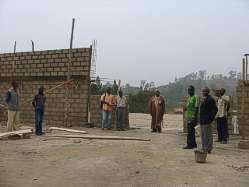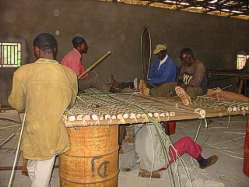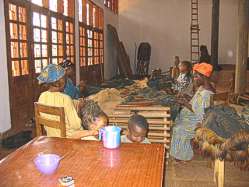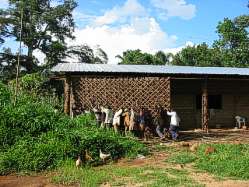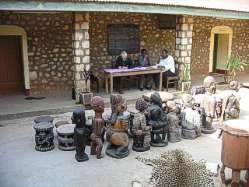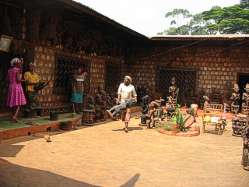
The project “ Training, protection of the artistic-cultural heritage and development in Cameroon” was started by the Italian NGO COE, Centro di Orientamento Educativo, based in Barzio ( Italy) and which has been present in Cameroon since 1970 with projects for development in the sectors of health, education, training and agriculture.
In Mbalmayo, in the central region of Cameroon, the COE is active as a Centre for Social Promotion. Amongst several other initiatives, in this town it founded the IFA, Institut de Formation Artistique, the only school with an artistic orientation currently operating in the country. The artistic heritage of Cameroon is thus to the fore of the attention of the COE, which has always been engaged in protecting the culture of the countries where it has development projects. The potential linked with the protection of the considerably rich Cameroon artistic heritage was the reason why the COE started this initiative.
The project was conceived and coordinated by the architect Bianca Triaca. Jean–Paul Notué, professor of art history, museology and anthropology at the University of Yaoundé I was appointed Scientific Director. The museographic project was assigned to the architect Antonio Piva, UNESCO, expert and professor of architecture and design at the Faculty of Architecture of the Politecnico of Milan.
The main objectives were as follows: to protect and develop the cultural and artistic heritage of Cameroon in the place where it exists; to encourage the dynamics of cultural and economic development in the areas concerned by the project and more in general in the country; to train young people in Cameroon in new professions in the field of the protection of cultural assets and to open up new job opportunities.
Starting off from an area in Cameroon, the Grassland, where the heritage is the richest and where the dangers of dispersion and decline of the objects of art are therefore more numerous, a commission chaired by Jean-Paul Notué identified four kingdoms as sites for the new museums. Mankon, Babungo, Baham and Bandjoun were chosen according to the following criteria: the presence of a significant heritage; the willingness of the traditional authorities to allow the study and social enjoyment of the objects belonging to the heritage of their communities; the degree of the desire and wishes of the place to have a modern and suitable museum; the commitment of the traditional authorities to put an appropriate building at the disposal of the project and on schedule. The COE took on the training of the future curators, layout and fitting out of the areas that were to house the collections in each museum and the cultural activities.
Twenty young people, with at least the ‘baccalauréat’ level of education, were selected after a competitive exam for training on museum activities. The programme included: theoretical training (1 st year), residential and with a vocational orientation at the IFA in Mbalmayo; a year of practical training (2 nd year) in the field at each museum, resulting in the documentation and planning of the collections, writing the information for the panels and catalogues; a year of managing the museums supported by the project with a monthly scholarship for the students throughout their training and the first year of operation of the four museums.
Cameroonian teachers and experts of the University of Yaoundé I and from the Cameroon Ministry for Culture (Department of national Heritage/Museums Head Office) as well as Italian experts gave the courses. The theoretical training programme, organised according to the indications of the ICOM (International Council of Museums), included four modules for a total of 800 hours, as well as visits to museums, art galleries, artists’ studios and field exhibitions:
- module 1: art, culture and heritage;
- module 2: museums, collections, theories and museological techniques;
- module 3: museum architecture, museographic techniques, conservation, restoration;
- module 4: cultural activities, introduction to IT and audiovisual techniques.
The lessons were held in two semesters each of which had an assessment at the end of the course.
The COE-IFA gave accommodation to the students during the eight months’ training and put at their disposal rooms for the lessons and practical work and exercises. A library specially provided with books on museology and museography was organised for the trainees and for the lecturers. The project gave the courses and then each museum computers, printers, masterizers, scanners. photocopiers, cameras and tape recorders. The expendable material, such as CDs, cassettes, paper etc. was also provided by the project. The students, according to their achievements, received a certificate at the end of the theoretical training.
During the second year of training, the activity took place in the field. The trainees studied the heritage of their chefferie with the supervision of the lecturers and in collaboration with the traditional institutions. The scientific coordinator checked the results of their surveys. Drawn up in line with the indications of the ICOM, they form the texts of the catalogues of the collections and the panels on display in each museum.
In early February 2003, the Italian architect Antonio Piva, lecturer in museography at the Faculty of Architecture of the Politecnico of Milan and a UNESCO collaborator, was in the field for the design of the museums. Everything was done using local materials, techniques and labour.
In October 2003, the four museums started their activity. Conceived to belong to the international community as well as belonging to the African, Cameroonian, local and regional contexts, they are active in consolidating the respect of social and cultural pluralities. The predominance of tradition in the permanent collections will be rewarded by the accent on the modernity characterising the temporary exhibitions.
In their activity, these museums contribute to the development of the cultural values which allow overcoming the gap between local and global, as well as between tradition and modernity. They open up new job opportunities and possibilities for development linked to the enhancement of an important resource of the country, whilst reinforcing the conscience of a rich cultural identity open to encounter and exchange with the cultures of the world.[ Top page ]
| Home | The four museums | The project | Baham museum | Bandjoun museum | Mankon museum | Babungo museum |
| Copyright 2005 C.O.E. | Powered by ADWS |
